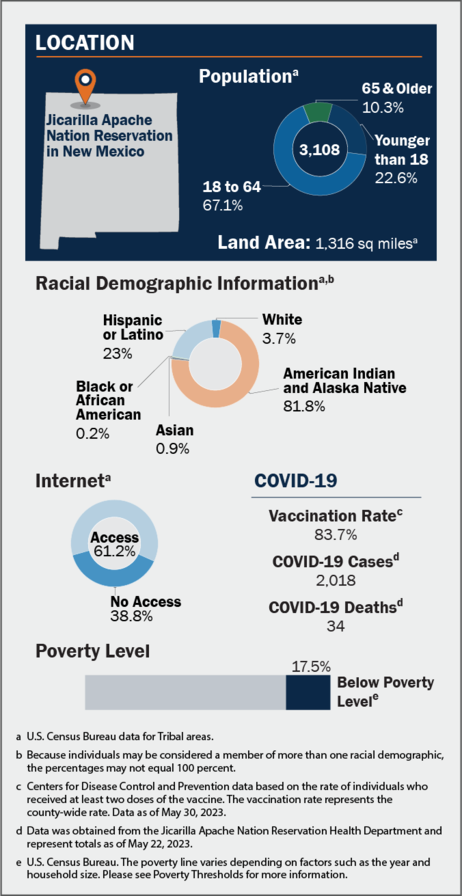Focus on Community: Jicarilla Apache Nation Reservation Located in New Mexico
Jicarilla Apache Nation Reservation was the fourth of six locations we visited to hear directly from local program administrators, Tribal leadership, and other community members about their experiences during the pandemic. The first Tribal nation we visited, Jicarilla Apache Nation Reservation has a population of 3,108 and a land area of 1,316 square miles that includes parts of Rio Arriba and Sandoval counties in New Mexico. The Tribal Government is located in the town of Dulce.
Jicarilla Apache Nation Reservation recipients, including the Tribal Government, small businesses, health services, and individuals, were awarded $80 million from 42 federal pandemic relief programs and subprograms from March 2020 to September 2021. Our report provides a closer look at how 10 programs and subprograms from six federal agencies helped Tribal leaders respond to and ease the effects of the pandemic on the community.

Jicarilla Apache Nation Reservation's unique experience
As of May 2023, Jicarilla Apache Nation Reservation had experienced 2,018 recorded cases of COVID-19 and 34 deaths. Tribal Government officials stated that while a nearby town’s COVID infection rate was twice as high as the COVID infection rate on the Reservation, the death rate was 11 times higher on the Reservation than in the town.
The Tribal Government used federal funds to sustain normal operations and mitigate challenges they faced responding to the pandemic. Challenges centered on remote learning, broadband and telecommunications access, food insecurity arising from the pandemic, distributing personal protective equipment (PPE), and sanitizing dormitories and other facilities.
To address challenges related to remote learning, Dulce Independent School District officials used Elementary and Secondary School Emergency Relief Program funding to purchase an additional copier, laptops, and headphones.
Tribal Government officials said the Farmers to Families Food Box Program helped to address food insecurity concerns which arose because of the pandemic.
Tribal Government officials also noted that Department of the Interior funding adequately addressed the need to sanitize education facilities, purchase PPE, connect computers with software to continue coursework for students, install several telecommunication towers to provide internet access, and provide student enrichment activities in dormitories and outdoor areas. However, officials also stated that the federal government could improve the allowable and prohibited expenses for new programs.
Federal programs’ impact on the community
Tribal officials used federal funding in many ways to respond to the pandemic:
The Jicarilla Apache Housing Authority (the Authority) received $422,000 in Indian Housing Block Grant (IHBG) funds from the Coronavirus Aid, Relief, and Economic Security (CARES) Act and nearly $945,000 in IHBG funds from the American Rescue Plan Act of 2021 (ARP). As of 2021, the Authority had spent all of the IHBG CARES Act grant and approximately $196,000 of its IHBG ARP Act grant to acquire PPE, maintain and upgrade buildings, and provide housing rental assistance.
The Department of the Treasury awarded approximately $18.91 million from the Coronavirus Relief Fund (CRF) to the Jicarilla Apache Nation. Tribal Government officials used the CRF funding to pay for salaries, construct a food distribution warehouse, and provide emergency housing as well as various technology upgrades.
These federal programs eased the effects of the pandemic that posed a serious threat to the health and welfare of the community. Read the full report on Jicarilla Apache Nation Reservation’s experiences.
Impact on Communities
To truly understand how the pandemic impacted people on the ground across the country, you have to get out into communities—both big and small, rural, urban and suburban—to appreciate the unique circumstances Americans faced. We did just that, examining six communities across the U.S. The report we reference on this page highlights one of those six communities’ experiences.


